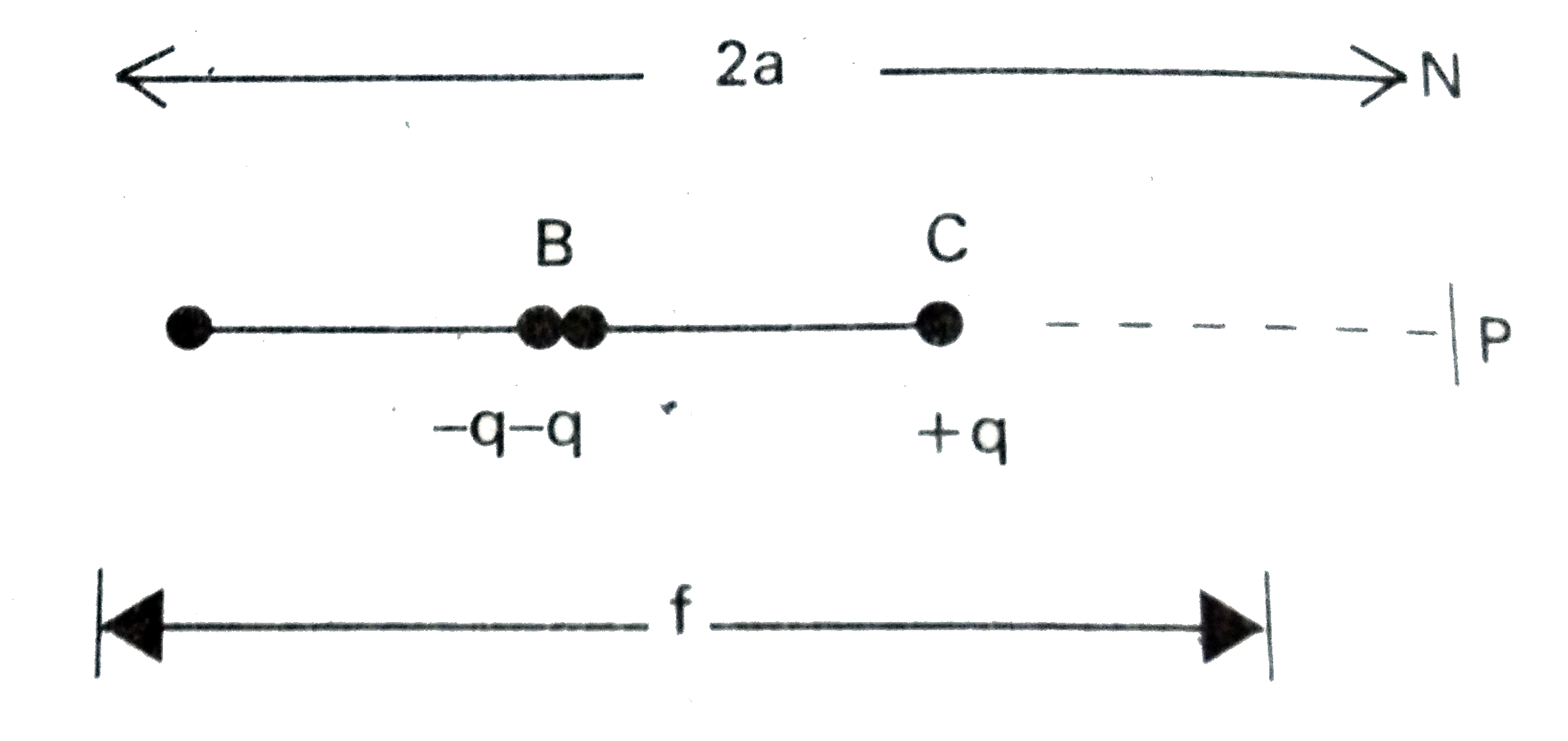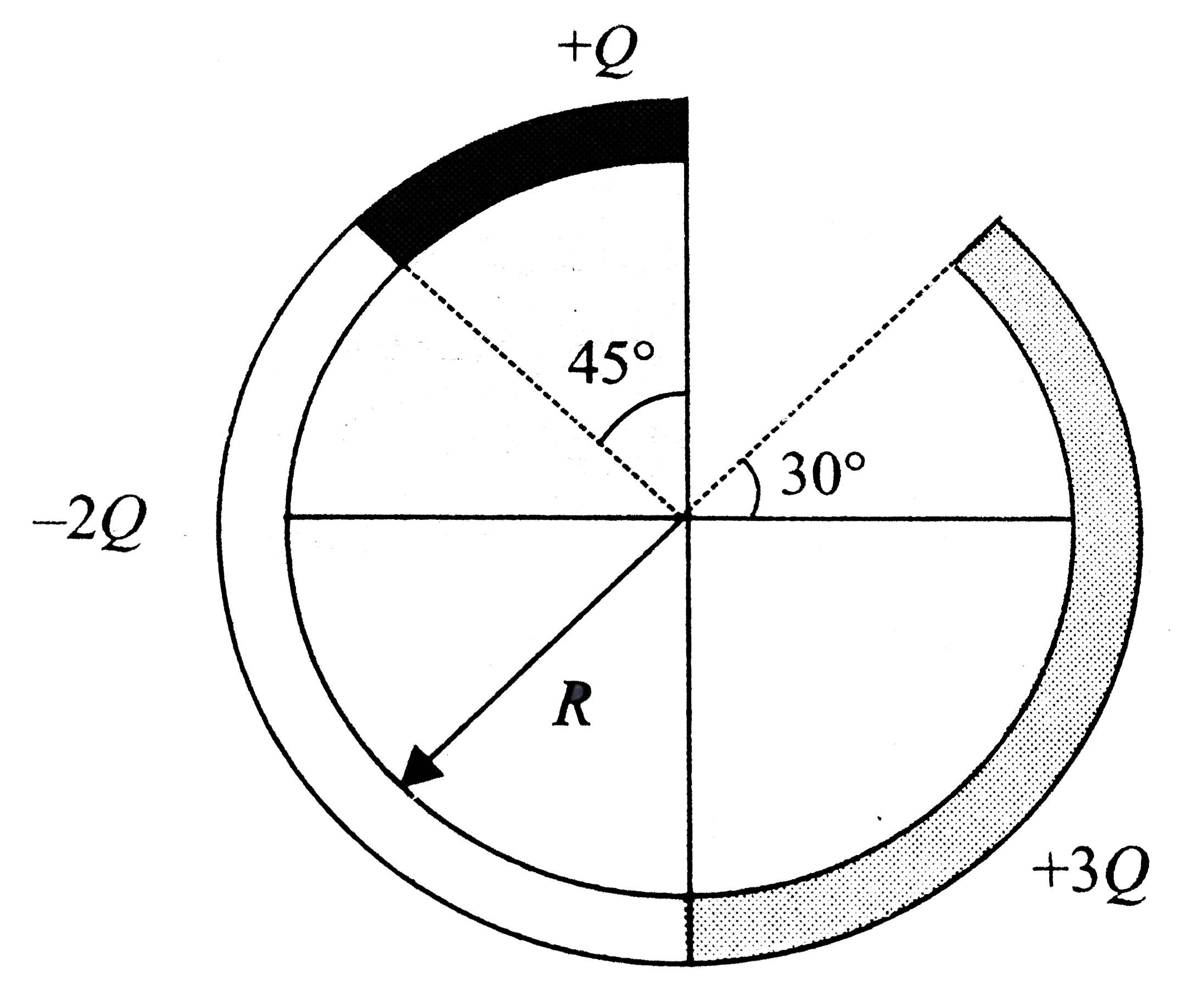Figure shows a charge array known as an electric qudarupole. For a point on the axis of the quadrupole , obtain the dependence of potential on r for r/a>>1. And contrast your results with that due to an electric dipole, and an electric monopole (i.e., a single charge).

As is clear from figure an electric quadrupole may be ragarded as a system of three charges +q, - 2q and + q at A,B and C respectively.
Let AC = 2a we have to calculate electric potential at any point P where BP = r, using superposition principle. Potential at p is given by
V=14πε0[qr+a−2qr+qr−a]
=q4πε0[r(r−a)−2(r+a)(r−a)+r(r+a)r(r2+a2)]
=q(r2−ra−2r2+r2+ra)4πε0r(r2−a2)
V=q.2a24πε0r(r2−a2)

V=q.2a24πε0r3(1−a2/r2)
ra>>1,r>>a or a<<r
∴a2r2 is negligibly small V=q.2a24πε0r3
clearly V∝1r3
In case of an electric dipole v∝1r2 and in case of an electric monopole
(i.e., a single charge), V∝1r
Topper's Solved these Questions
- ELECTROSTATIC POTENTIAL AND CAPACITANCEBook:VIKRAM PUBLICATION ( ANDHRA PUBLICATION)Chapter:ELECTROSTATIC POTENTIAL AND CAPACITANCEExercise:Textual Examples
Explore 10 Videos
- ELECTROSTATIC POTENTIAL AND CAPACITANCEBook:VIKRAM PUBLICATION ( ANDHRA PUBLICATION)Chapter:ELECTROSTATIC POTENTIAL AND CAPACITANCEExercise:Important Questions
Explore 3 Videos
- ELECTROSTATIC POTENTIAL AND CAPACITANCEBook:VIKRAM PUBLICATION ( ANDHRA PUBLICATION)Chapter:ELECTROSTATIC POTENTIAL AND CAPACITANCEExercise:Textual Exercises
Explore 11 Videos
- ELECTROMAGNETIC WAVEBook:VIKRAM PUBLICATION ( ANDHRA PUBLICATION)Chapter:ELECTROMAGNETIC WAVEExercise:ADDITIONAL EXERCISES
Explore 19 Videos
- MAGNETISM AND MATTERBook:VIKRAM PUBLICATION ( ANDHRA PUBLICATION)Chapter:MAGNETISM AND MATTERExercise:Additional Exercises
Explore 19 Videos
Similar Questions
Fig shows a charge array known as an 'electric quadrupole'. For a point on the axis of the quadrupole, obtain the dependence of potential on r for r/a>>1, and contract your results with that due to an electric dipole and an electric monopole (i.e, a single charge).

View SolutionFig shows a charge array known as an 'electric quadrupole'. For a point on the axis of the quadrupole, obtain the dependence of potential on r for r/a>>1, and contract your results with that due to an electric dipole and an electric monopole (i.e, a single charge).

View Solution
Knowledge Check
The electric potential at a point on the axis of an electric dipole depends on the distance r of the point from the dipole as
A∝1rB∝1r2C∝rD∝1r3The electric potential V at a point on the axis of an electric dipole depends on the distance 'r of the point from the dipole as
AV∝1rBV∝1r2CV∝1r3DV∝r(Figure 3.139) shows three circular arcs, each of radius R and total charge as indicated. The net electric potential at the center of curvature.
 .AQ2πε0RB5Q12πε0RC3Q32πε0RDnone of these
.AQ2πε0RB5Q12πε0RC3Q32πε0RDnone of these
The figure given below shows a charge array known as an 'electric quadrupole'. For a point on the axis of the quadrupole, obtain the dependence of potential on r for ra>>1. Contrast your result with that due to an electric dipole and an electric monopole (i.e. a single charge).

View SolutionFigure shows a charge array known as an "electric quadrupole". For a point on the axis of the quadruple, the dependence of potential on r(ra>>1) is 1rn. Find n?

View SolutionFigure shows a charge array known as an "electric quadrupole". For a point on the axis of the quadruple, the dependence of potential on r(ra>>1) is 1rn. Find n?

View SolutionDeduce an expression for the electric potential due to an electric dipole at any point on its axis. Mention one contrasting feature of electric potential of a dipole at a point as compared to that due to a single charge.
View SolutionDeduce an expression for the electric potential due to an electric dipole at any point on its axis. Mention one contrasting feature of electric potential at a point due to dipole as compared to that due to a single charge.
View Solution

